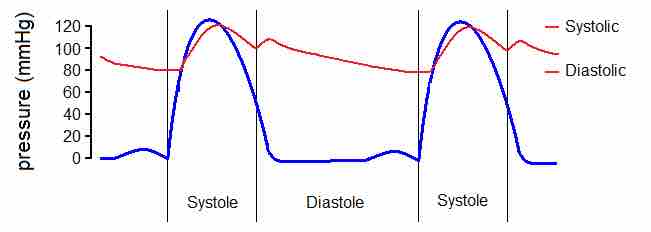The cardiac cycle is the term used to describe the relaxation and contraction that occur as the heart works to pump blood through the body. Heart rate is a term used to describe the frequency of the cardiac cycle. It is considered one of the four vital signs and is a regulated variable. Usually heart rate is calculated as the number of contractions (heartbeats) of the heart in one minute and expressed as "beats per minute" (bpm). When resting, the adult human heart beats at about 70 bpm (males) and 75 bpm (females), but this varies among individuals. The reference range is normally between 60 bpm (lower is termed bradycardia) and 100 bpm (higher is termed tachycardia). Resting heart rates can be significantly lower in athletes and significantly higher in the obese. The body can increase the heart rate in response to a wide variety of conditions in order to increase the cardiac output, the blood ejected by the heart, which improves oxygen supply to the tissues.
Pulse
Pressure waves generated by the heart in systole, or ventricular contraction, move the highly elastic arterial walls. Forward movement of blood occurs when the arterial wall boundaries are pliable and compliant. These properties allow the arterial wall to distend when pressure increases, resulting in a pulse that can be detected by touch. Exercise, environmental stress, or psychological stress can cause the heart rate to increase above the resting rate. The pulse is the most straightforward way of measuring the heart rate, but it can be a crude and inaccurate measurement when cardiac output is low. In these cases (as happens in some arrhythmias), there is little pressure change and no corresponding change in pulse, and the heart rate may be considerably higher than the measured pulse.
Cardiac Cycle
Every single heartbeat includes three major stages: atrial systole, ventricular systole, and complete cardiac diastole.
- Atrial systole is the contraction of the atria that causes ventricular filling.
- Ventricular systole is the contraction of the ventricles in which blood is ejected into the pulmonary artery or aorta, depending on side.
- Complete cardiac diastole occurs after systole. The blood chambers of the heart relax and fill with blood once more, continuing the cycle.
Systolic and Diastolic Blood Pressure
Throughout the cardiac cycle, the arterial blood pressure increases during the phases of active ventricular contraction and decreases during ventricular filling and atrial systole. Thus, there are two types of measurable blood pressure: systolic during contraction and diastolic during relaxation. Systolic blood pressure is always higher than diastolic blood pressure, generally presented as a ratio in which systolic blood pressure is over diastolic blood pressure. For example, 115/75 mmHg would indicated a systolic blood pressure of 115 mmHg and a diastolic blood pressure or 75 mmHG. The normal range for blood pressure is between 90/60 mmHg and 120/80 mmHg. Pressures higher than that range may indicate hypertension, while lower pressures may indicate hypotension. Blood pressure is a regulated variable that is directly related to blood volume, based on cardiac output during the cardiac cycle.

The Cardiac Cycle
Changes in contractility lead to pressure differences in the heart's chambers that drive the movement of blood.